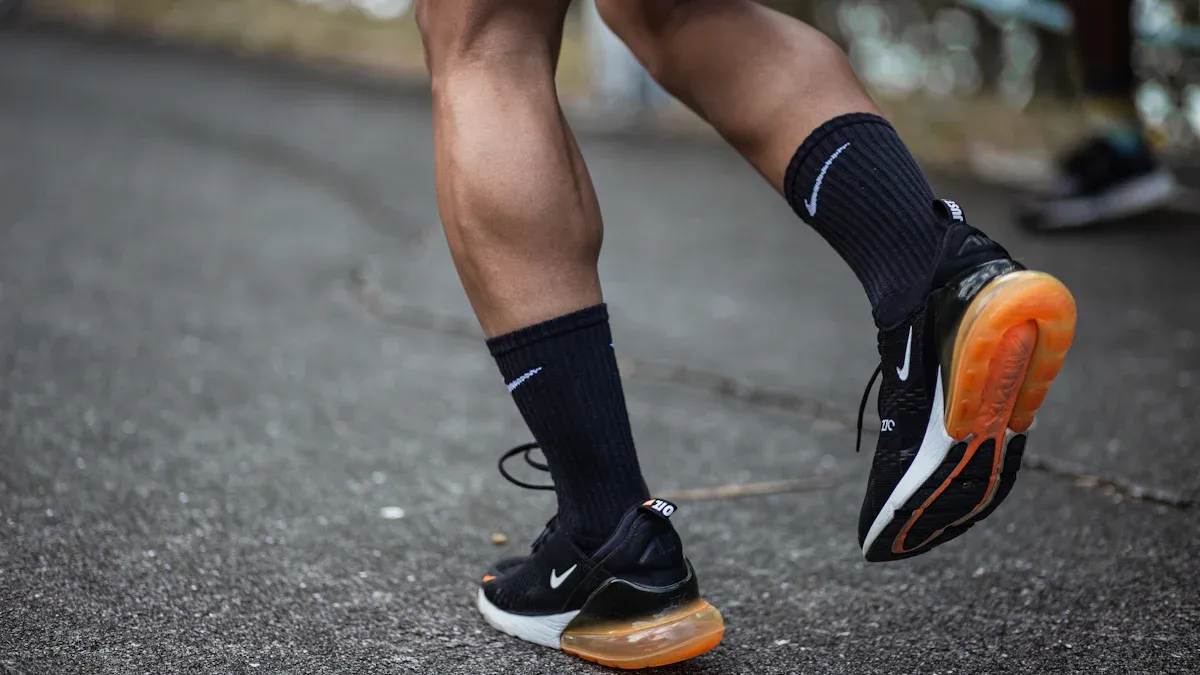
Ever felt like your feet were on fire during a workout? I have, and trust me, it’s not fun. Breathable socks are a game-changer. They keep your feet cool, dry, and blister-free, even during those grueling sessions.
Did you know that 73% of athletes believe the right socks can boost performance? That’s no surprise. Socks with moisture-wicking features and proper support help you stay focused and comfortable.
Plus, the athletic sock market is booming, showing just how important they’ve become. So, why settle for discomfort when breathable socks can make every step better?
Key Takeaways
- Breathable socks help keep your feet cool and dry. This stops blisters and discomfort during exercise.
- Materials like Merino wool and polyester blends pull sweat away. They also help stop bad smells.
- Socks with mesh areas let air flow better. This makes them more comfortable for hard workouts.
- Compression socks help blood move faster. They can reduce swelling and help you recover quicker after exercise.
- Picking the right sock thickness can improve how you perform. Thicker socks give more cushion, while thinner ones feel lighter.
- Choose socks with arch and ankle support. These can lower strain and help prevent injuries while working out.
- Check your socks often for damage. Replace them every 6-12 months to keep them working well.
- Buying good breathable socks can make workouts better. They also help keep your feet healthy.
Why Breathable Socks Are Important for Hard Workouts
Stopping Blisters and Smelly Feet
Have you ever stopped a workout because of blisters? I have, and it’s awful. Blisters happen when sweat and rubbing hurt your skin. Breathable socks help by keeping your feet dry. They pull sweat away and lower friction, so blisters don’t form.
Now, let’s talk about smelly feet. Nobody likes bad smells after exercising. Breathable socks often use special materials like silver or zinc oxide. These stop bacteria from growing, which causes bad odors. Since bacteria love warm, wet places, these socks keep your feet fresh. It’s like a freshness shield for your feet!
Controlling Sweat and Wetness
Sweaty feet can ruin your workout. When socks don’t handle sweat well, feet feel sticky and heavy. Breathable socks fix this with sweat-wicking fabrics. These pull sweat off your skin and let it dry fast.
Research supports this. Fabrics like polyester mesh and Tencel single jersey keep feet cooler and less sweaty. This means more comfort and less wetness. Socks with mesh areas also let air flow better. It’s like giving your feet their own fan!
| Fabric Type | Foot Temperature | Foot Wetness | Energy Use | Heart Rates |
|---|---|---|---|---|
| Tencel Single Jersey (TS) | Cooler | Drier | Lower | Lower |
| Polyester Mesh (PM) | Cooler | Drier | Lower | Lower |
| Other Fabrics | Warmer | Wetter | Higher | Higher |
Helping You Perform and Recover Better
Did you know socks can help you recover faster? I didn’t until I tried breathable socks with compression. These socks improve blood flow, bringing oxygen to muscles and removing waste. This means less pain and faster recovery after workouts.
Breathable socks also reduce swelling by boosting circulation. After a long run or gym session, my feet feel less swollen with these socks. It’s like a mini spa for your feet while you exercise.

What Makes a Sock Truly Breathable?
Have you ever wondered why some socks feel amazing while others make your feet sweaty? I’ve been there, and not all socks are the same. Let’s look at what makes breathable socks so important for workouts.
Fabric Choices: Cotton vs Synthetic vs Merino Wool
The type of fabric in socks matters a lot for breathability. I’ve tried cotton, synthetic, and Merino Wool, and each has its own strengths and weaknesses.
- Merino Wool: This is the best choice for breathable socks. It’s soft, keeps moisture away, and adjusts to temperature. Whether it’s hot or cold, Merino Wool keeps my feet comfy. It also fights bad smells, which is great after tough workouts.
- Synthetic Materials: These are strong and dry fast. They don’t hold sweat like cotton but aren’t as breathable as Merino Wool.
- Cotton: Cotton lets air through but isn’t good for workouts. It soaks up sweat and stays wet, which can cause blisters.
Merino Wool is the top pick for moisture-wicking and comfort. Cotton doesn’t work well when wet, and synthetic fabrics are better than cotton but not as good as Merino Wool.
Here’s a simple comparison:
- Merino Wool: Best for staying dry and comfortable.
- Synthetic Materials: Good for strength and quick drying.
- Cotton: Breathable but bad for sweaty workouts.
Mesh Zones and Knit Structure
Have you seen socks with small mesh areas? They’re not just for style—they help with airflow. Socks with mesh zones let air move around, keeping your feet cool during hard workouts. I always pick socks with mesh on the top or sides of the foot.
The way socks are knitted also matters. Studies show that how a sock is made affects how much air can pass through it. For example:
| Study | Focus | Findings |
|---|---|---|
| Havlová, M. (2013) | Air permeability and constructional parameters | Shows how fabric design impacts air flow. |
| Umair, M. et al. (2016) | Structure of woven fabric | Explains how fabric design helps with air and moisture control. |
| Zhu, G. et al. (2018) | Structural parameters of cotton woven fabric | Predicts air flow based on fabric design. |
| Marie, H. (2018) | Air and water vapor permeability | Studies how fabric design affects air and water flow. |
From my experience, socks with terry knits feel thicker and warmer. Jersey knits are thinner and let more air through. For the best airflow, pick socks with loose knits and mesh zones.
Moisture-Wicking Technology
Moisture-wicking is what keeps your feet dry during sweaty workouts. I’ve tried socks with different moisture-wicking fabrics, and the difference is huge.
Here’s what I’ve learned:
- Wool, especially Merino Wool, absorbs a lot of moisture without feeling wet. It can hold 30-50% of its weight in moisture.
- Synthetic fabrics like polyester and nylon also work well. Polyester moves heat away from your skin, helping you stay cool.
- The knit style matters too. Terry knits hold more moisture but feel heavier. Jersey knits are lighter and dry faster.
| Evaluation Type | Findings |
|---|---|
| Fiber Composition | Wool holds the most moisture, while cotton holds three times more than acrylic. |
| Knit Structure | Terry knits create less friction than jersey knits, helping with moisture control. |
| Thermal Conductivity | Polyester moves heat away better than polyamide, keeping feet cooler. |
| Moisture Regain | Wool absorbs the most moisture, making it great for staying dry. |
| Friction Coefficient | Terry knits reduce friction, lowering the chance of blisters. |
I once wore socks without good moisture-wicking on a long run. My feet felt soaked and uncomfortable. Now, I always choose socks with advanced moisture-wicking to stay dry and happy.
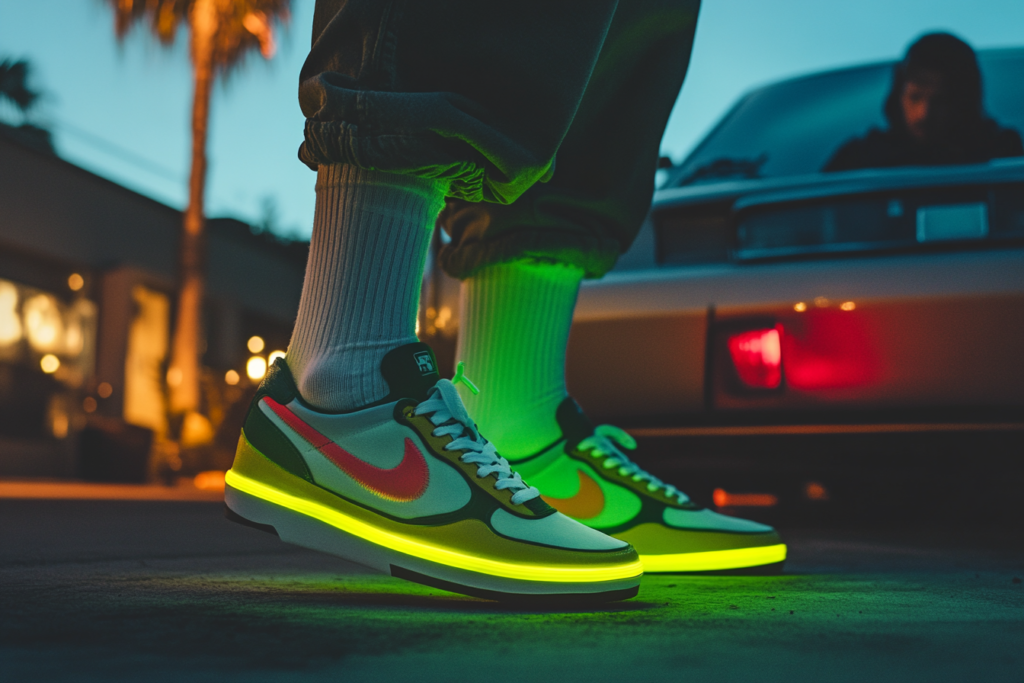
What's the Best Materials for Breathable Socks
The material of socks matters a lot for workouts. I’ve tested many types, and some are better for keeping feet comfy, dry, and durable. Let’s explore the top three materials for breathable socks.
Polyester Blends
Polyester blends are popular among athletes, including me. These socks mix polyester with other fibers for strength and comfort. They’re great at pulling sweat away from your skin. During tough workouts, my feet stay dry, which helps prevent blisters.
Here’s why polyester blends are so effective:
| Benefit | Why It’s Important |
|---|---|
| Moisture-wicking | They pull sweat away, keeping feet dry and comfortable. |
| Durability | These blends make socks last longer, even during intense activities. |
| Comfort | The mix of fibers makes them soft and perfect for active use. |
If you need socks for hard workouts, polyester blends are a reliable option.
Merino Wool
Merino wool is like a superhero for socks. It’s soft, breathable, and adjusts to temperature changes. I’ve worn Merino wool socks in both hot summers and cold winters, and they always perform well. They keep feet dry by pulling sweat away and also stop bad smells.
Here’s why Merino wool is amazing:
- It pulls sweat off your skin, stopping bacteria and odors.
- It lets air flow, keeping feet cool and dry, unlike cotton.
- It keeps you warm without feeling heavy, thanks to its lightweight insulation.
Merino wool lasts longer than regular wool. It costs more, but the comfort and quality are worth it.
Bamboo Fiber
Bamboo fiber isn’t as famous as polyester or Merino wool, but it’s fantastic. I wasn’t sure about it at first, but after trying bamboo socks, I loved them. They’re super soft and breathable, making them great for long workouts or daily wear.
Here’s what makes bamboo fiber unique:
| Feature | Why It’s Great |
|---|---|
| Moisture-wicking | Keeps feet dry and stops blisters with natural sweat-wicking properties. |
| Breathability | Mesh areas improve airflow, keeping feet cool and comfy. |
| Comfort | Flat designs reduce rubbing and feel smooth on the skin. |
Bamboo socks also feel cooler, which is awesome for summer workouts. If you haven’t tried them, you’re missing out on great comfort.
Nylon with Spandex
When I first tried socks made with nylon and spandex, I wasn’t sure what to expect. But wow, they were a game-changer! These materials work together to create socks that are stretchy, durable, and super comfortable. If you’ve ever struggled with socks that slip down or feel too tight, nylon with spandex might be the solution you didn’t know you needed.
Here’s why I love socks with nylon and spandex:
- Stretch and Fit: Spandex adds just the right amount of stretch. It hugs your feet without feeling restrictive. Whether you’re running, lifting weights, or doing yoga, these socks stay in place. No more stopping mid-workout to pull your socks up!
- Durability: Nylon is tough. It can handle intense workouts and frequent washing without losing its shape. I’ve had nylon-spandex socks that lasted for months, even with daily use.
Tip: Look for socks with at least 5-10% spandex. This ensures they’re stretchy enough to fit snugly but not so tight that they cut off circulation.
Why Nylon with Spandex Is Perfect for Workouts
These materials aren’t just about comfort—they’re also great for performance. Nylon is lightweight and breathable, which keeps your feet cool during intense workouts. Spandex adds flexibility, so your socks move with you instead of against you.
Here’s a quick breakdown of their benefits:
| Material | Key Feature | Why It’s Great for Socks |
|---|---|---|
| Nylon | Lightweight and durable | Keeps socks breathable and long-lasting |
| Spandex | Stretchy and flexible | Ensures a snug fit without slipping |
I’ve noticed that socks with nylon and spandex also dry quickly. After a sweaty workout, they’re ready to go again in no time. This is especially helpful if you’re someone who exercises daily.
My Experience with Nylon-Spandex Socks
One time, I wore nylon-spandex socks for a long hike. My feet stayed dry and comfortable the entire time. The socks didn’t bunch up or slide down, even after hours of walking. I didn’t get any blisters, which was a huge relief.
If you’re looking for socks that combine breathability, durability, and a perfect fit, nylon with spandex is worth trying. Trust me, your feet will thank you!
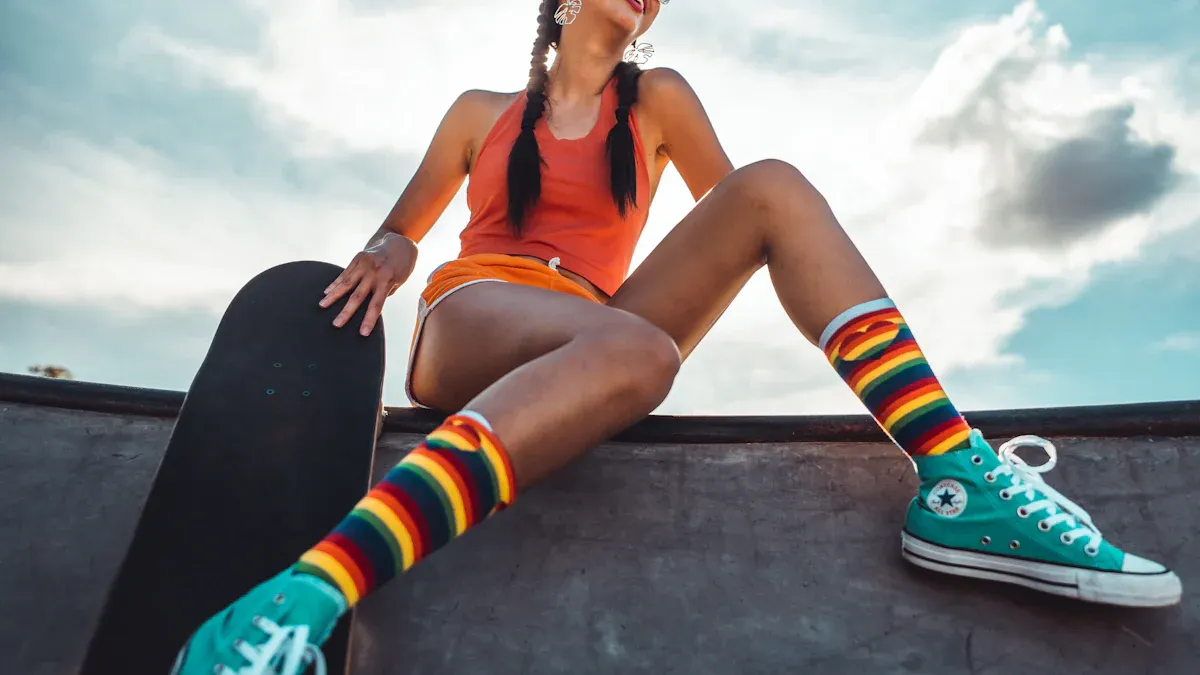
How to Choosing the Best Breathable Socks for Sweaty Feet
Finding the right breathable socks for sweaty feet can feel overwhelming. I’ve been there, staring at endless options and wondering what really matters. Let me break it down for you.
Cushioning vs Thin
When it comes to cushioning, it’s all about balance. Thick socks offer more padding, which is great for absorbing impact during high-intensity workouts. I’ve noticed they’re perfect for activities like running or jumping, where your feet take a beating. On the other hand, thin socks give you a lightweight, natural feel. They’re my go-to for yoga or weightlifting, where I want more control and less bulk.
Here’s a quick comparison to help you decide:
| Feature | Thick Socks | Thin Socks |
|---|---|---|
| Cushioning | Superior cushioning for impact absorption | Minimal cushioning, more natural feel |
| Breathability | Less breathable, retains heat | Excellent breathability, regulates temperature |
| Weight | Heavier, provides more padding | Lightweight, offers a minimalist experience |
| Quick Drying | Slower drying time | Dries faster, ideal for wet conditions |
| Fit | Looser fit, may feel bulkier | Snug fit, enhances control and responsiveness |
| Blister Prevention | Reduces friction, helps prevent blisters | Less padding, may increase blister risk |
| Comfort in Cold Weather | Provides warmth in colder climates | Less insulation, not ideal for cold weather |
Personally, I prefer thick socks for running and thin ones for gym workouts. It’s all about matching the sock to the activity.
Tip: If you’re prone to blisters, go for thicker socks with extra padding. They reduce friction and keep your feet happy.
Arch and Ankle Support
Arch and ankle support can make or break your workout. I learned this the hard way after a few painful runs. Socks with built-in support hug your feet in all the right places, reducing strain and preventing injuries.
Studies back this up. For example:
| Study | Findings |
|---|---|
| Babins EM (2012) | Lace-up ankle braces reduced acute ankle injuries in high school basketball players. |
| McGuine TA et al. (2011) | The effect of lace-up ankle braces on injury rates in high school football players. |
| Handoll HH et al. (2001) | Meta-analysis provided evidence for the beneficial effect of ankle braces to prevent ankle sprains during high-risk sports. |
I’ve also noticed that socks with arch compression improve my stability during workouts. They keep my feet from sliding around, which helps me stay focused.
Note: Look for socks with targeted compression zones. They provide extra support where you need it most, like the arches and ankles.
Length: Crew, Ankle, No-Show
Sock length might seem like a small detail, but it can make a big difference. I’ve tried them all—crew, ankle, and no-show—and each has its perks.
- Crew Socks: These are great for activities like hiking or cycling. They protect your legs from scratches and provide extra warmth in cooler weather.
- Ankle Socks: Perfect for running or gym workouts. They’re short enough to stay out of the way but still offer some coverage.
- No-Show Socks: These are my favorite for casual wear or low-impact activities. They’re invisible in most shoes and feel super lightweight.
Tip: Choose the length based on your activity and personal preference. For example, I wear crew socks for trail runs to avoid dirt and ankle socks for treadmill sessions.
No matter the length, make sure your socks fit well and stay in place. There’s nothing worse than socks that slide down mid-workout!
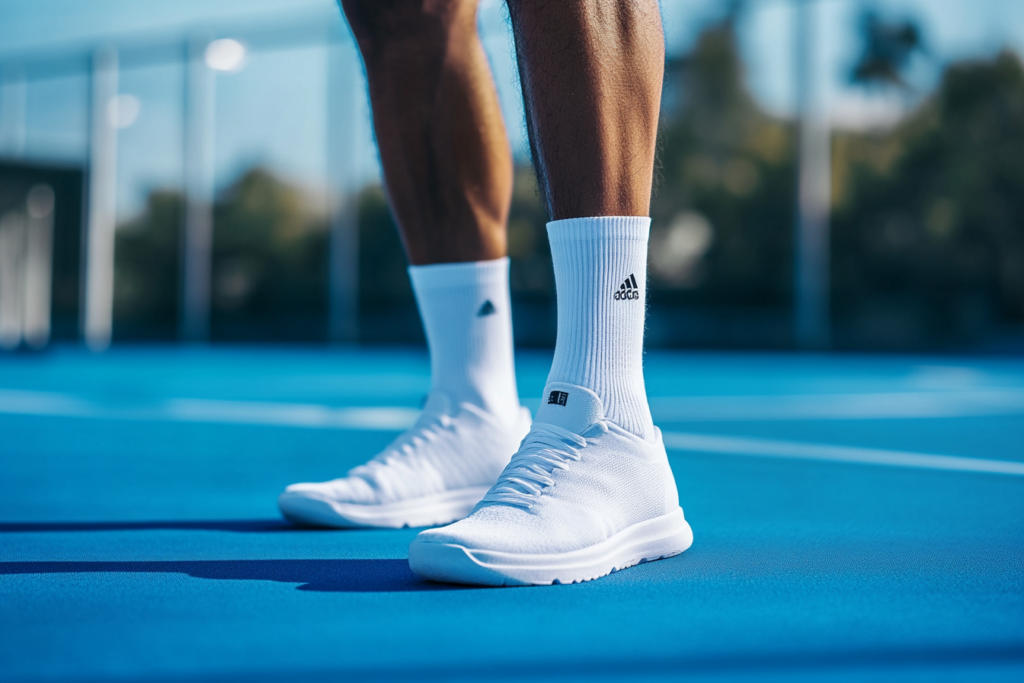
What Breathable Socks You Can Trust
Finding great breathable socks can feel tricky. After trying many, I’ve found three brands that are the best. They offer comfort, performance, and last a long time. Let me share my favorites with you.
Nike Dri-FIT Socks: Features and Benefits
Nike Dri-FIT socks are always in my workout bag. These socks are made for athletes, and it’s easy to see why. The Dri-FIT material pulls sweat away fast, keeping my feet dry during tough workouts.
The fit is snug and supportive. The arch compression helps reduce tiredness, and the reinforced heel and toe make them strong. Whether I’m running or lifting, these socks stay in place and feel amazing.
Why Nike Dri-FIT socks are awesome:
- Moisture-Wicking: Keeps feet dry and comfy.
- Arch Support: Helps reduce foot pain during long workouts.
- Durability: Strong design makes them last longer.
Fun Fact: Many pro athletes love Nike Dri-FIT socks. They’re built for high-energy activities, making them a top choice for fitness lovers.
Balega Hidden Comfort Socks: Features and Benefits
Balega Hidden Comfort socks feel super soft and cozy. I was amazed by how comfortable they are. The extra padding is great for running or hiking. Even with the cushioning, they don’t feel heavy, which is awesome.
These socks use Balega’s Drynamix fibers to keep feet dry. Even on hot days, my feet stay cool. The seamless toe and deep heel pocket stop slipping, so I never have to fix them mid-run.
| Feature | Description |
|---|---|
| Moisture Wicking | Drynamix fibers keep feet cool and dry. |
| Cushioning | Soft padding adds comfort without bulk. |
| No-Slip Design | Seamless toe and heel tab stop slipping. |
| Fit | Deep heel pocket keeps socks in place. |
| Quality Assurance | Checked by hand and comes with a one-year warranty. |
Pro Tip: If you get blisters often, try Balega Hidden Comfort socks. Their soft design protects your skin really well.
Smartwool Performance Socks: Features and Benefits
Smartwool Performance socks are perfect for any activity. Whether I’m at the gym or hiking in winter, they work great. The secret is the Merino Wool. It’s light, breathable, and keeps feet comfy in all weather.
These socks are also very strong. Thanks to Indestructawool technology, they last through many washes. They fit perfectly, with just enough stretch to stay snug without being tight.
Why Smartwool Performance socks are a great pick:
- Breathability: Merino Wool keeps air flowing and feet dry.
- Durability: Indestructawool makes them last longer.
- Comfort: Soft and light, great for all-day wear.
Did You Know? Smartwool socks are loved for stopping blisters and keeping feet at the right temperature. Hikers and athletes trust them.
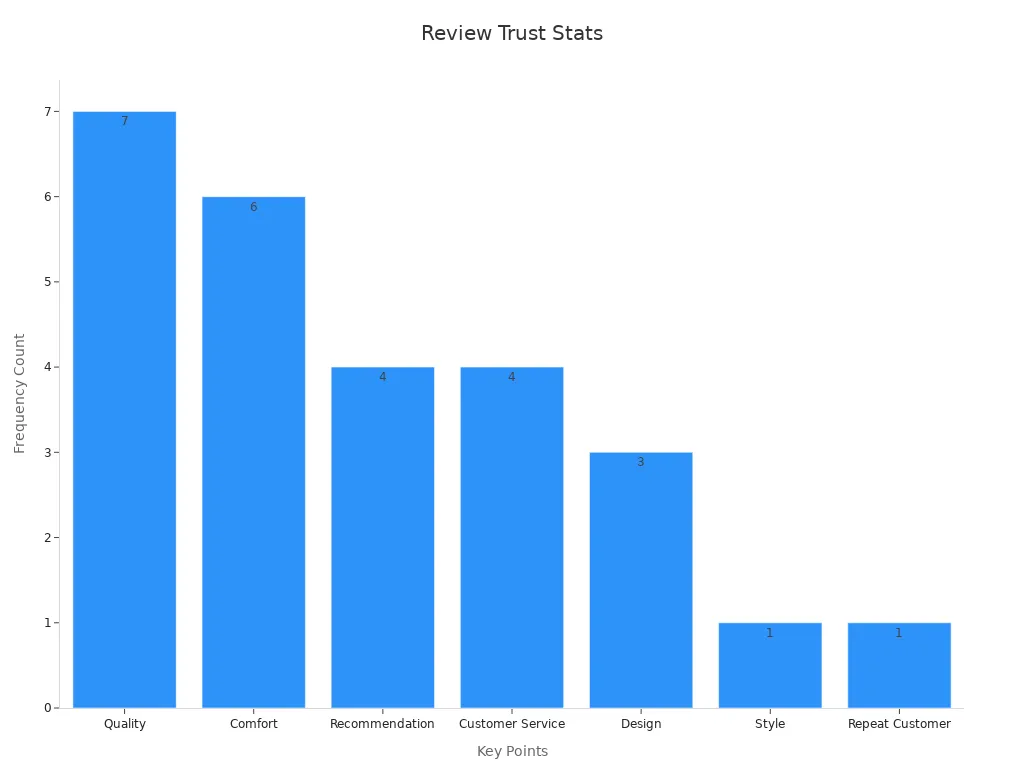
These three brands are my top choices for breathable socks. Whether you run, go to the gym, or just want comfy socks, you’ll love these options.
How to Care for Your Breathable Socks
Taking care of your breathable socks isn’t just about keeping them clean. It’s about making sure they stay effective and last longer. I’ve learned a few tricks over the years, and I’m excited to share them with you.
Washing Tips to Retain Breathability
Washing socks might seem simple, but breathable socks need a little extra love. The wrong washing method can ruin their moisture-wicking abilities or stretch them out. Here’s how I keep mine in top shape:
- Check the Label: Always read the care instructions. Some socks, like those made with Merino wool, need gentle handling.
- Use Cold Water: Hot water can damage the fibers and reduce breathability. I always stick to cold or lukewarm water.
- Skip the Fabric Softener: Fabric softeners leave a residue that blocks moisture-wicking properties. Trust me, your socks don’t need it.
- Turn Them Inside Out: This protects the outer fabric and ensures the inner part gets thoroughly cleaned.
- Air Dry Whenever Possible: Tossing them in the dryer can weaken the elastic and shrink the material. I lay mine flat to dry, and they stay in great shape.
Pro Tip: Use a mesh laundry bag to keep your socks from getting lost or tangled with other clothes. It’s a game-changer!
When to Replace Your Socks
Even the best socks don’t last forever. Over time, they lose their stretch, cushioning, and breathability. I’ve learned to spot the signs that it’s time for a new pair:
- Worn-Out Fabric: If you notice thinning areas or holes, it’s time to say goodbye. Thin spots mean less protection and more risk of blisters.
- Loss of Elasticity: Socks that slide down or feel loose around your feet aren’t doing their job anymore.
- Persistent Odor: If your socks still smell after washing, bacteria might have settled in the fibers. New socks are the only fix.
- Reduced Comfort: If your feet feel damp or uncomfortable during workouts, the moisture-wicking properties might be gone.
I usually replace my workout socks every 6-12 months, depending on how often I use them. Keeping track of their condition helps me avoid surprises during a workout.
Reminder: Investing in high-quality socks might cost more upfront, but they last longer and perform better. It’s worth it!
Taking care of your breathable socks doesn’t take much effort, but it makes a big difference. Follow these tips, and your socks will keep your feet happy for many workouts to come.

Conclusion
Breathable socks are more than just workout gear—they’re a game-changer. They keep your feet dry, prevent blisters, and even boost performance. I’ve seen how the right socks can make workouts more comfortable and enjoyable. With the socks market expected to grow from USD 46.9 billion in 2023 to USD 80.5 billion by 2033, it’s clear that breathable socks are in high demand. Innovations like moisture-wicking fabrics are making them better than ever.
So, why wait? Treat your feet to the comfort they deserve. Explore the latest options and find your perfect pair today. Your workouts will thank you!
FAQ
What makes breathable socks different from regular socks?
Breathable socks use special fabrics like Merino wool or polyester blends. They wick sweat away and allow airflow to keep feet dry. Regular socks often trap moisture, which can lead to discomfort and blisters.
Can breathable socks help with sweaty feet?
Absolutely! Breathable socks are designed to manage sweat. They pull moisture away from your skin and dry quickly. I’ve noticed my feet stay cooler and fresher during workouts when I wear them.
Are breathable socks worth the extra cost?
Yes, they’re worth it. High-quality breathable socks last longer and improve comfort during workouts. I’ve found they prevent blisters and keep my feet dry, which makes exercising more enjoyable.
How do I know if my socks are breathable?
Check the fabric and design. Look for moisture-wicking materials like Merino wool or polyester. Mesh zones and lightweight knits also improve airflow. If your socks feel cool and dry during workouts, they’re breathable.
Can I wear breathable socks for everyday use?
Of course! Breathable socks aren’t just for workouts. I wear them daily because they keep my feet comfortable and odor-free. They’re great for long walks, casual outings, or even lounging at home.
How long do breathable socks last?
It depends on how often you use them. I replace mine every 6-12 months. Signs like thinning fabric, loss of stretch, or persistent odor mean it’s time for a new pair.
Do breathable socks work in cold weather?
Yes, they do! Merino wool socks are perfect for cold weather. They keep your feet warm while wicking away moisture. I’ve worn them on winter hikes, and my feet stayed cozy and dry.
Are there breathable socks for specific sports?
Definitely! Brands like Nike and Smartwool make socks tailored for running, hiking, and cycling. I’ve tried sport-specific socks, and they offer better support and durability for those activities.
Related
1.20 TOP SOCKS STATISTICS IN 2025 →
2.Socks for Any Occasion: From Sport to Casual Life →
3.The 3 Types Of Blister Prevention Socks →
4.Effect of different garments on thermophysiological and psychological comfort properties of athletes in a wear trial test →
5.The Best Compression Socks of 2024 →
